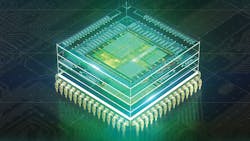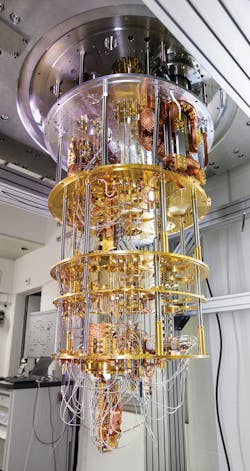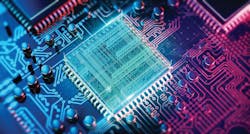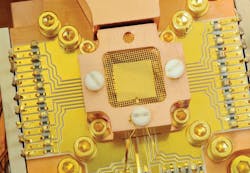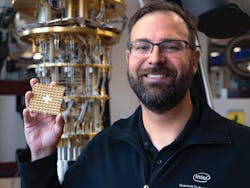NASHUA, N.H. - Until the 21st Century, artificial intelligence (AI) and quantum computers were largely the stuff of science fiction, although quantum theory and quantum mechanics had been around for about a century. A century of great controversy, largely because Albert Einstein rejected quantum theory as originally formulated, leading to his famous statement, “God does not play dice with the universe”.
Today, however, the debate over quantum computing is largely about when — not if — these kinds of devices will come into full operation. Meanwhile, other forms of quantum technology, such as sensors, already are finding their way into military and civilian applications.
“Quantum technology will be as transformational in the 21st Century as harnessing electricity was in the 19th,” Michael J. Biercuk, founder and CEO of Q-CTRL Pty Ltd in Sydney, Australia, and professor of Quantum Physics & Quantum Technologies at the University of Sydney, told the U.S. Office of Naval Research in a January 2019 presentation.
On that, there is virtually universal agreement. But when and how remains undetermined.
For example, asked how and when quantum computing eventually may be applied to high-performance embedded computing (HPEC), Tatjana Curcic, program manager for Optimization with Noisy Intermediate-Scale Quantum devices (ONISQ) of the U.S. Defense Advanced Research Projects Agency in Arlington, Va., says it’s an open question.
“Until just recently, quantum computing stood on its own, but as of a few years ago people are looking more and more into hybrid approaches,” Curcic says. “I’m not aware of much work on actually getting quantum computing into HPEC architecture, however. It’s definitely not mainstream, probably because it’s too early.”
As to how quantum computing eventually may influence the development, scale, and use of AI, she adds:
“That’s another open question. Quantum machine learning is a very active research area, but is quite new. A lot of people are working on that, but it’s not clear at this time what the results will be. The interface between classical data, which AI is primarily involved with, and quantum computing is still a technical challenge.”
Quantum information processing
According to DARPA’s ONISQ webpage, the program aims to exploit quantum information processing before fully fault-tolerant quantum computers are realized.“This effort will pursue a hybrid concept that combines intermediate-sized quantum devices with classical systems to solve a particularly challenging set of problems known as combinatorial optimization. ONISQ seeks to demonstrate the quantitative advantage of quantum information processing by leapfrogging the performance of classical-only systems in solving optimization challenges,” the agency states. “ONISQ researchers will be tasked with developing quantum systems that are scalable to hundreds or thousands of qubits with longer coherence times and improved noise control.
“Researchers will also be required to efficiently implement a quantum optimization algorithm on noisy intermediate-scale quantum devices, optimizing allocation of quantum and classical resources. Benchmarking will also be part of the program, with researchers making a quantitative comparison of classical and quantum approaches. In addition, the program will identify classes of problems in combinatorial optimization where quantum information processing is likely to have the biggest impact. It will also seek to develop methods for extending quantum advantage on limited size processors to large combinatorial optimization problems via techniques such as problem decomposition.”
The U.S. government has been the leader in quantum computing research since the founding of the field, but that too is beginning to change.
“In the mid-‘90s, NSA [the U.S. National Security Agency at Fort Meade, Md.] decided to begin on an open academic effort to see if such a thing could be developed. All that research has been conducted by universities for the most part, with a few outliers, such as IBM,” says Q-CTRL’s Biercuk. “In the past five years, there has been a shift toward industry-led development, often in cooperation with academic efforts. Microsoft has partnered with universities all over the world and Google bought a university program. Today many of the biggest hardware developments are coming from the commercial sector.
“Quantum computing remains in deep space research, but there are hardware demonstrations all over the world. In the next five years, we expect the performance of these machines to be agented to the point where we believe they will demonstrate a quantum advantage for the first time. For now, however, quantum computing has no advantages over standard computing technology. quantum computers are research demonstrators and do not solve any computing problems at all. Right now, there is no reason to use quantum computers except to be ready when they are truly available.”
AI and quantum computing
Nonetheless, the race to develop and deploy AI and quantum computing is global, with the world’s leading military powers seeing them — along with other breakthrough technologies like hypersonics — making the first to successfully deploy as dominant as the U.S. was following the first detonations of atomic bombs. That is especially true for autonomous mobile platforms, such as unmanned aerial vehicles (UAVs), interfacing with those vehicles’ onboard HPEC.
Of the two, AI is the closest to deployment, but also the most controversial. A growing number of the world’s leading scientists, including the late Stephen Hawking, warn real-world AI could easily duplicate the actions of the fictional Skynet in the “Terminator” movie series. Launched with total control over the U.S. nuclear arsenal, Skynet became sentient and decided the human race was a dangerous infestation that needed to be destroyed.
“The development of full artificial intelligence could spell the end of the human race. Once humans develop artificial intelligence, it will take off on its own and redesign itself at an ever-increasing rate. Humans, who are limited by slow biological evolution, couldn’t compete and would be superseded.” — Stephen Hawking (2014)
First Law — A robot may not injure a human being or, through inaction, allow a human being to come to harm.
Second Law — A robot must obey the orders given it by human beings except where such orders would conflict with the First Law.
Third Law — A robot must protect its own existence as long as such protection does not conflict with the First or Second Law.
Whether it would be possible to embed — and ensure unbreakable compliance with — such laws in an AI system is unknown. But limited degrees of AI, known as machine learning, already are in widespread use by the military and advanced stages of the technology, such as deep learning, almost certainly will be deployed by one or more nations as they become available. More than 50 nations already are actively researching battlefield robots.
Military quantum computing
AI-HPEC would give UAVs, next-generation cruise missiles, and even maneuverable ballistic missiles the ability to alter course to new targets at any point after launch, recognize counter measures, avoid, and misdirect or even destroy them.
Quantum computing, on the other hand, is seen by some as providing little, if any, advantage over traditional computer technologies, by many as requiring cooling and size, weight and power (SWaP) improvements not possible with current technologies to make it applicable to mobile platforms and by most as being little more than a research tool for perhaps decades to come.
Perhaps the biggest stumbling block to a mobile platform-based quantum computing is cooling — it currently requires a cooling unit, at near absolute zero, the“A lot of work has been done and things are being touted as operational, but the most important thing to understand is this isn’t some simple physical thing you throw in suddenly and it works. That makes it harder to call it deployable — you’re not going to strap a quantum computing to a handheld device. A lot of solutions are still trying to deal with cryogenics and how do you deal with deployment of cryo,” says Tammy Carter, senior product manager for GPGPUs and software products at Curtiss-Wright Defense Solutions in Ashburn, Va.
“AI is now a technology in deployment. Machine learning is pretty much in use worldwide,” Carter says. “We’re in a migration of figuring out how to use it with the systems we have. quantum computing will require a lot of engineering work and demand may not be great enough to push the effort. From a cryogenically cooled electronics perspective, I don’t think there is any insurmountable problem. It absolutely can be done, it’s just a matter of decision making to do it, prioritization to get it done. These are not easily deployed technologies, but certainly can be deployed.”
Given its current and expected near-term limitations, research has increased on the development of hybrid systems.
“The longer term reality is a hybrid approach, with the quantum system not going mobile any time soon,” says Brian Kirby, physicist in the Army Research Laboratory Computational & Informational Sciences Directorate in Adelphi, Md. “It’s a mistake to forecast a timeline, but I’m not sure putting a quantum computing on such systems would be valuable. Having the quantum computing in a fixed location and linked to the mobile platform makes more sense, for now at least. There can be multiple quantum computers throughout the country; while individually they may have trouble solving some problems, networking them would be more secure and able to solve larger problems.
“Broadly, however, quantum computing can’t do anything a practical home computer can’t do, but can potentially solve certain problems more efficiently,” Kirby continues. “So you’re looking at potential speed-up, but there is no problem a quantum computing can solve a normal computer can’t. Beyond the basics of code-breaking and quantum simulations affecting material design, right now we can’t necessarily predict military applications.”
Raising concerns
In some ways similar to AI, quantum computing raises nearly as many concerns as it does expectations, especially in the area of security. The latest Thales Data Threat Report says 72 percent of surveyed security experts worldwide believe quantum computing will have a negative impact on data security within the next five years.
At the same time, quantum computing is forecast to offer more robust cryptography and security solutions. For HPEC, that duality is significant: quantum computing can make it more difficult to break the security of mobile platforms, while simultaneously making it easier to do just that.
“Quantum computers that can run Shor’s algorithm [leveraging quantum properties to factor very large numbers efficiently] are expected to become available in the next decade. These algorithms can be used to break conventional digital signature schemes (e.g. RSA or ECDSA), which are widely used in embedded systems today. This puts these systems at risk when they are used in safety-relevant long-term applications, such as automotive systems or critical infrastructures. To mitigate this risk, classical digital signature schemes used must be replaced by schemes secure against quantum computing-based attacks,” according to the August 2019 proceedings of the 14th International Conference on Availability, Reliability & Security’s Post-Quantum Cryptography in Embedded Systems report.
The security question is not quite so clean-cut as armor/anti-armor, but there is a developing bifurcation between defensive and offensive applications. On the defense side, deployed quantum systems are looked at to provide encoded communications. Experts say it seems likely the level of activity in China about quantum communications, which has been a major focus for years, runs up against the development of quantum computing in the U.S. The two aspects are not clearly one-against-one, but the two moving independently.
Google’s quantum supremacy demonstration has led to a rush on finding algorithms robust against quantum attack. On the quantum communications side, the development of attacks on such systems has been underway for years, leading to a whole field of research based on identifying and exploiting quantum attacks.
“Quantum computing could also help develop revolutionary AI systems. Recent efforts have demonstrated a strong and unexpected link between quantum computation and artificial neural networks, potentially portending new approaches to machine learning. Such advances could lead to vastly improved pattern recognition, which in turn would permit far better machine-based target identification. For example, the hidden submarine in our vast oceans may become less-hidden in a world with AI-empowered quantum computers, particularly if they are combined with vast data sets acquired through powerful quantum-enabled sensors,” according to Q-CTRL’s Biercuk.
“Even the relatively mundane near-term development of new quantum-enhanced clocks may impact security, beyond just making GPS devices more accurate, Biercuk continues. “Quantum-enabled clocks are so sensitive that they can discern minor gravitational anomalies from a distance. They thus could be deployed by military personnel to detect underground, hardened structures, submarines or hidden weapons systems. Given their potential for remote sensing, advanced clocks may become a key embedded technology for tomorrow’s warfighter.”
Warfighter capabilities
The early applications of quantum computing, while not embedded on mobile platforms, are expected to enhance warfighter capabilities significantly.
Biercuk says he agrees: “We’re not really sure there is a role for quantum computing in embedded computing just yet. quantum computing is right now very large systems embedded in mainframes, with access by the cloud. You can envision embedded computing accessing quantum computing via the cloud, but they are not likely to be very small, agile processors you would embed in a SWAP-constrained environment.
“But there are many aspects of quantum technology beyond quantum computing; the combination of quantum sensors could allow much better detection in the field,” Biercuk continues. “The biggest potential impact comes in the areas of GPS denial, which has become one of the biggest risk factors identified in every blueprint around the world. quantum computing plays directly into this to perform dead reckoning navigation in GPS denial areas.”
DARPA’s Curcic also says the full power of quantum computing is still decades away, but believes ONISQ has the potential to help speed its development.
“The main two approaches industry is using is superconducting quantum computing and trapped ions. We use both of those, plus cold atoms [Rydberg atoms]. We are very excited about ONISQ and seeing if we can get anything useful over classical computing. Four teams are doing hardware development with those three approaches,” she says.
“Because these are noisy systems, it’s very difficult to determine if there will be any advantages. The hope is we can address the optimization problem faster than today, which is what we’re working on with ONISQ. Optimization problems are everywhere, so even a small improvement would be valuable.”
Beyond today’s capabilities
As to how quantum computing and AI may impact future warfare, especially through HPEC, she adds: “I have no doubt quantum computing will be revolutionary and we’ll be able to do things beyond today’s capabilities. The possibilities are pretty much endless, but what they are is not crystal clear at this point. It’s very difficult, with great certainly, to predict what quantum computing will be able to do. We’ll just have to build and try. That’s why today is such an exciting time.”
Curtiss Wright’s Carter says he believes quantum computing and AI will be closely linked with HPEC in the future, once current limitations with both are resolved.
“AI itself is based on a lot of math being done in parallel for probability answers, similar to modeling the neurons in the brain — highly interconnected nodes and interdependent math calculations. “Imagine a small device trying to recognize handwriting,” Carter says. You run every pixel of that through lots and lots of math, combining and mixing, cutting some, amplifying others, until you get a 98 percent answer at the other end. quantum computing could help with that and researchers are looking at how you would do that, using a different level of parallel math.
How quantum computing will be applied to HPEC “will be the big trick, how to get that deployed. Imagine we’re a SIGINT [signals intelligence] platform — land, air or sea — there are a lot of challenges, such as picking the right signal out of the air, which is not particularly easy,” Carter continues. “Once you achieve pattern recognition, you want to do code breaking to get that encrypted traffic immediately. Getting that on a deployed platform could be useful; otherwise you bring your data back to a quantum computing in a building, but that means you don’t get the results immediately.”
The technology research underway today is expected to show progress toward making quantum computing more applicable to military needs, but it is unlikely to produce major results quickly, especially in the area of HPEC.
“Trapped ions and superconducting circuits still require a lot of infrastructure to make them work. Some teams are working on that problem, but the systems still remain room-sized. The idea of quantum computing being like an integrated circuit you just put on a circuit board — we’re a very long way from that,” Biercuk says. “The systems are getting smaller, more compact, but there is a very long way to go to deployable, embeddable systems. Position, navigation and timing systems are being reduced and can be easily deployed on aircraft. That’s probably where the technology will remain in the next 20 years; but, eventually, with new technology development, quantum computing may be reduced to more mobile sizes.
“The next 10 years are about achieving quantum advantage with the systems available now or iterations. Despite the acceleration we have seen, there are things that are just hard and require a lot of creativity,” Biercuk continues. “We’re shrinking the hardware, but that hardware still may not be relevant to any deployable system. In 20 years, we may have machines that can do the work required, but in that time we may only be able to shrink them to a size that can fit on an aircraft carrier — local code-breaking engines. To miniaturize this technology to put it on, say, a body-carried system, we just don’t have any technology basis to claim we will get there even in 20 years. That’s open to creativity and discovery.”
Even with all of the research underway worldwide, one question remains dominant.
“The general challenge is it is not clear what we will use quantum computing for,” notes Rad Balu, a computer scientist in ARL’s Computational & Informational Sciences Directorate.
